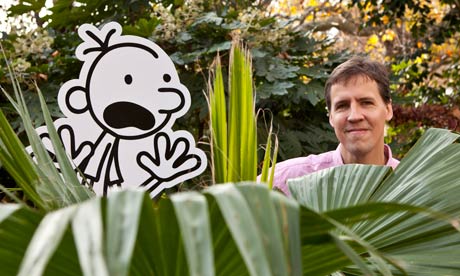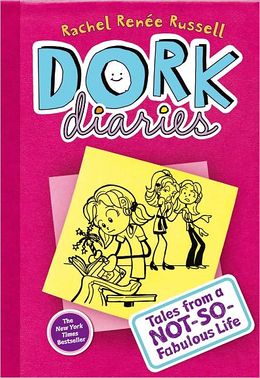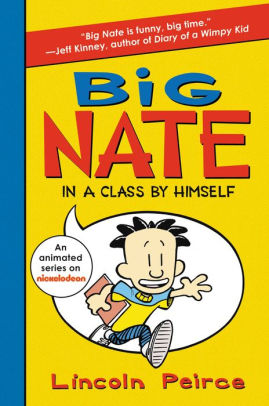 Jeff Kinney currently sits at the top of a $550 million empire, and it all started with a web comic. When Kinney’s ambition to write a comic strip for syndication floundered on his limited art ability, he started posting a strip called “Diary of a Wimpy Kid” on FunBrain.com, the website arm of the educational publisher Pearson. Since he had recently landed a job as developer of educational video games for Pearson—a position he still holds–he could bypass any number of gatekeepers.
Jeff Kinney currently sits at the top of a $550 million empire, and it all started with a web comic. When Kinney’s ambition to write a comic strip for syndication floundered on his limited art ability, he started posting a strip called “Diary of a Wimpy Kid” on FunBrain.com, the website arm of the educational publisher Pearson. Since he had recently landed a job as developer of educational video games for Pearson—a position he still holds–he could bypass any number of gatekeepers.
The web comic was originally conceived for adults who remembered their middle school years—or The Pits, as some recall. But 7th-grade hero Greg Heffley struck such a nerve with readers closer to his age that by the time Diary of a Wimpy Kid was published as a hardcover middle-grade novel, it already had thousands of fans.
Part of its success owes to timing. The Wimpy Kid filled the “novel-in-comics” gap left by the temporary retirement of Captain Underpants, and it appealed to a wider audience. As mentioned before, Greg attends middle school: “The dumbest idea ever invented,” according to him. “You got kids like me who haven’t hit their growth spurt yet mixed in with these gorillas who need to shave twice a day.” Preach it, Greg: I got to spend eighth grade being home-schooled, but sixth and seventh grades were definitely fraught, especially as I was the slowest in my class to “develop” (in bra size) and painfully shy besides.
Greg Heffley started out in Book #1 as an anti-hero loser, who casually double-crosses his friend Rowley and still comes out worse for it. By Book #7 (The Third Wheel, published last September), he has appearances to keep up as the world’s most famous 7th-grader. Meaning in this latest book he’s merely a loser. Middle-grade material may be getting harder to come by; before

Rowley
getting down to Third Wheel business Greg treats us to a twelve-page recollection of himself as a pre-born infant and baby. The plot then starts building up to its main thread, the Valentine Dance: finding a date for, shelling out bucks for, arranging transportation for, etc. But no WK novel is known for its hard-driving storyline. Getting to the Valentine Dance takes us through the school assembly diversion, the toilet-paper diversion (toilet paper being a WK standby), and the Mad Pantser diversion. The dance itself, like every WK scenario, is an extended exposition of Murphy’s Law, from running up an outrageous bill at Corny’s Family Restaurant to getting crashed by senior citizens at the dance. This is all pretty innocent fun even if Greg’s ideas about prayer need correction: “I started worrying that you only had a certain number of prayers answered in your lifetime and I’m burning through mine too fast. I’d hate to find out later on that I’ve used up all my chits . . .”
He belongs to an intact family, goes to church, and doesn’t use bad language, but a good role model Greg is not—everybody admits that, but some fans find his moral obtuseness endearing. He appears to know right from wrong, but doesn’t always—okay, he almost never–lets it get in the way of personal advantage. (The saving grace is that none of his schemes work out as planned—cheating and lying do not pay in Greg’s world.) Typical of preadolescent boys? Typical of all of us, deep down. He’s instructive in a negative way: “There is none righteous.”
Greg’s chief virtue for teachers and many parents is that kids can’t resist him–especially “reluctant readers,” who are predominantly boys. If you have one of those, Diary of a Wimpy Kid probably won’t do much damage, but I would, first, snatch the book from the hands of readers younger than ten, and, second, discuss the hero with your 10-to-13-year-old. Would you like to have Greg as a friend? Would you trust him to take care of the family dog for a weekend? Do you share any character traits, good or bad? Does Greg have any especially good character traits?
 Is it funny? Yep. In fact, when Kinney plans a new novel, he writes the jokes and pratfalls first, then a first-person narrative strung between the jokes, and finally the primitive cartoons. It’s all about funny, and there’s nothing wrong with that. Middle-schoolers need to laugh as much as (or more than) anybody, and the great thing about humor—especially the self-mocking kind—is that it gives us perspective. While Greg mercilessly ridicules other kids, the author subtly or not-so-subtly makes him the butt of the jokes. Some middle-school readers may be reaching for WK as a lifeline, to reassure themselves that however dorky they are, there’s always somebody dorkier. If they’re learning to laugh at themselves, that’s even better.
Is it funny? Yep. In fact, when Kinney plans a new novel, he writes the jokes and pratfalls first, then a first-person narrative strung between the jokes, and finally the primitive cartoons. It’s all about funny, and there’s nothing wrong with that. Middle-schoolers need to laugh as much as (or more than) anybody, and the great thing about humor—especially the self-mocking kind—is that it gives us perspective. While Greg mercilessly ridicules other kids, the author subtly or not-so-subtly makes him the butt of the jokes. Some middle-school readers may be reaching for WK as a lifeline, to reassure themselves that however dorky they are, there’s always somebody dorkier. If they’re learning to laugh at themselves, that’s even better.
Speaking of dorks: girls are generally more eager readers than boys, but they stampede to The Dork Diaries, another novel- in-comics series obviously whipped up from the winning formula of WK. Nikki Maxwell’s drawings are much more sophisticated, as she is a budding artist whose style is heavily influenced by manga. Otherwise, she’s forever running afoul of the Fashion Police, chasing after plans that get out of hand, and stumbling from one breathless OMG! situation to the next. Her main challenge and central conflict is establishing a sense of self in an arena ruled by the CCP’s—Cute, Cool, and Popular girls. Also finding a non-nerdy boyfriend. She may be reassuring to girls in the same way that Greg is reassuring to boys, but I’m not a fan. If your girls are reasonably fond of reading and interested in a variety of subjects, there are plenty of better books to steer them toward.
in-comics series obviously whipped up from the winning formula of WK. Nikki Maxwell’s drawings are much more sophisticated, as she is a budding artist whose style is heavily influenced by manga. Otherwise, she’s forever running afoul of the Fashion Police, chasing after plans that get out of hand, and stumbling from one breathless OMG! situation to the next. Her main challenge and central conflict is establishing a sense of self in an arena ruled by the CCP’s—Cute, Cool, and Popular girls. Also finding a non-nerdy boyfriend. She may be reassuring to girls in the same way that Greg is reassuring to boys, but I’m not a fan. If your girls are reasonably fond of reading and interested in a variety of subjects, there are plenty of better books to steer them toward.

Sixth-grader Nate Wright, the most successful WK imitator, does not suffer like Greg from low self-esteem. Big Nate began as a syndicated comic strip way back in the nineties but undoubtedly received a boost from WK’s success, leading to a series of best-selling chapter books beginning in 2010. Nate confidently assumes he will one day achieve greatness in soccer, music (via his garage band, Enslave the Mollusk), cartooning (specializing in caricatures of teachers), or table football–which might, admittedly, be a hard way to make a living. His issues, unlike Greg’s, are more with grownups than peers, chiefly his divorced dad and his teachers. One teacher in particular: “When a teacher completely snaps and starts screaming, it’s called a full Godfrey. When Mrs. Godfrey does it, it’s called Monday.” Nate doesn’t pose the moral conundrums of WK. He has a bad attitude about conventional school, but then, so do a lot of us. (“Dude, I know I have potential. I’m just saving it for something more important than school.”) He’s more for fun, and again, there’s nothing wrong with that, as long as middle schoolers also know when sorrow and regret are appropriate.
Other writers to jump on the novel-in-comics-series bandwagon, to a greater or lesser degree, are James Patterson (Middle School: The Worst Years of My Life) and Janet Tashjian (My Life as a Book). Those in-between years are obviously a deep well of comic material that will never run dry, and some of these woebegone characters will undoubtedly introduce book-shy kids to the peculiar pleasures of reading words on a page. That doesn’t mean we should shove just any book at a reluctant reader to get him to read; some books should be avoided, period, but others are open to parental discretion. Three questions to ask yourself:
- Are the subject matter, vocabulary, and/or character qualities without any redeeming features?
- Is this book a complete waste of time?
- Can I have a discussion about this with my kids?
The last question is especially important: Christian parents should be teaching their children to exercise discernment for themselves. In the process of developing a fine palate for excellence, they’re bound to waste some time and devour a few stinkers (a class in which I don’t necessarily include Wimpy Kid). As long as they can talk it over with a wise teacher or parent, even that can be a learning experience.
Stay Up to Date!
Get the information you need to make wise choices about books for your children and teens.
Our weekly newsletter includes our latest reviews, related links from around the web, a featured book list, book trivia, and more. We never sell your information. You may unsubscribe at any time.
Support our writers and help keep Redeemed Reader ad-free by joining the Redeemed Reader Fellowship.
Stay Up to Date!
Get the information you need to make wise choices about books for your children and teens.
Our weekly newsletter includes our latest reviews, related links from around the web, a featured book list, book trivia, and more. We never sell your information. You may unsubscribe at any time.
We'd love to hear from you!
Our comments are now limited to our members (both Silver and Golden Key). Members, you just need to log in with your normal log-in credentials!
Not a member yet? You can join the Silver Key ($2.99/month) for a free 2-week trial. Cancel at any time. Find out more about membership here.
9 Comments
Leave a Comment
You must be logged in to post a comment.

Such an amazing post, Janie.
I just love Diary of a wimpy kid. I like how it talks about like real things going on in middle school like popularity and rumors it shows real stuff happening in real life. This is a treat for the mind. It is perfect for kids and adults and every one In between. Although it has crude hummer I’ve read worse books. I think everybody should have a chance to read this book. I recommend this book for all ages. Can’t wait to read the all the other books in the series.
Thank you for writing an informed and well-balanced assessment of these types of books! My daughter is an avid reader well advanced for her age (5th grade, about to be 11.) It’s difficult to keep her in appropriate books… and even more difficult for me to keep up with her as she can get through 300 pages of young adult fiction in 2-3 days!
She picked up the WK series in the second half of 3rd grade, and I wasn’t exactly thrilled – especially after reading the first book. It was funny and clever, but it was disappointing to find out what a jerk the main character was! I chose to do exactly what you suggest here – ask questions that led my daughter to evaluate Greg’s actions based on Biblical standards. She did great, and agreed that Greg Heffley could use some lessons in selflessness and friendship.
That summer she read books 1-4, and I had her tell me about the story (as thin as it is)… but now she’s pretty much lost interest in those. Too simple for her taste!
The problem for me as a K-12 school librarian is that the middle school kids do not read the WK books. It’s the younger kids who want them — the third, fourth, fifth graders. I don’t have them for that reason. Of course, I’ve got 4th graders who are just carrying around The Hobbit as well — it’s the biggest problem for me — how to get kids to read age-appropriate books?
Carol,
It seems to be a principle of children’s publishing that kids read a little above their intended grade level–which is why I have a hard time recommending most YA books. I completely understand why you don’t order WK for third-graders! It’s not that every elementary school kid is going to take Greg for a role model, but they need something a little more positive at that age.
You’re a bit kinder to the WK series than I was, Janie, but I totally agree–and I absolutely agree that kids need a chance to read “the fun stuff” and not merely the deep, heavy stuff–especially the struggling and/or apathetic readers. I feel the same way about Babymouse and Lunchlady books which I’ve been drafting a post about. I’ll include a link to this one and mention WK!
Betsy: I’ll look forward to your post on Babymouse. I met Matt Holm once, a very neat guy, but never got around to reading the books. so thanks for that.
Another thing about Big Nate: He’s kind of weird. I mean Lincoln Peirce is desperate for laughs (no offense) that he’s willing to to make a character half psycho half middle schooler for it.
Thank you, Janie!! My niece just passed several of these titles on to my 9yo, and I’ve not been eager to encourage him to read them. I think they’ll probably be conveniently forgotten and discarded. 🙂
Hi i like it